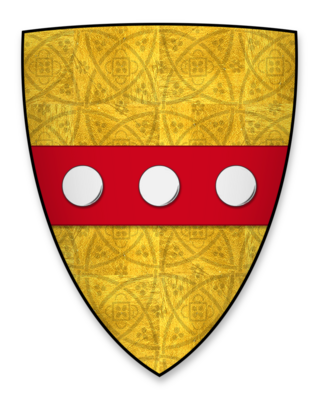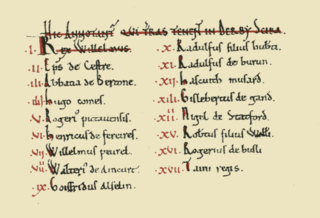Related Research Articles

Knaresborough Castle is a ruined fortress overlooking the River Nidd in the town of Knaresborough, North Yorkshire, England.

The Rebellion of 1088 occurred after the death of William the Conqueror and concerned the division of lands in the Kingdom of England and the Duchy of Normandy between his two sons William Rufus and Robert Curthose. Hostilities lasted from 3 to 6 months starting around Easter of 1088.
The Revolt of 1173–1174 was a rebellion against King Henry II of England by three of his sons, his wife Eleanor of Aquitaine, and their rebel supporters. The revolt ended in failure after eighteen months; Henry's rebellious family members had to resign themselves to his continuing rule and were reconciled to him.

Sir Robert de Ros was an Anglo-Norman feudal baron, soldier and administrator who was one of the twenty-five barons appointed under clause 61 of the 1215 Magna Carta agreement to monitor its observance by King John of England.

de Lacy is the surname of an old Norman family which originated from Lassy, Calvados. The family took part in the Norman Conquest of England and the later Norman invasion of Ireland. The name is first recorded for Hugh de Lacy (1020–1085). His sons, Walter and Ilbert, left Normandy and travelled to England with William the Conqueror. The awards of land by the Conqueror to the de Lacy sons led to two distinct branches of the family: the northern branch, centred on Blackburnshire and west Yorkshire was held by Ilbert's descendants; the southern branch of Marcher Lords, centred on Herefordshire and Shropshire, was held by Walter's descendants.
Robert I de Brus, 1st Lord of Annandale was an early-12th-century Anglo-Norman lord and the first of the Bruce dynasty to hold lands in Scotland. A monastic patron, he is remembered as the founder of Gisborough Priory in Yorkshire, England, in present-day Redcar and Cleveland, in 1119.

William of Huntingfield was a medieval English baron, Sheriff of Norfolk and Suffolk and one of the Magna Carta sureties.
Eustace fitz John, Constable of Chester, was a powerful magnate in northern England during the reigns of Henry I, Stephen and Henry II. From a relatively humble background in South East England, Eustace made his career serving Henry I, and was elevated by the king through marriage and office into one of the most important figures in the north of England. Eustace acquired a great deal of property in the region, controlled Bamburgh Castle, and served jointly with Walter Espec as justiciar of the North.
Philip de Valognes, Lord of Ringwood, Benvie and Panmure was an Anglo-Norman Scottish noble. He was the Lord Chamberlain of Scotland between 1165–1171 and 1193–1214.
Robert de Vieuxpont, also called Vipont, Veteripont, or de Vetere Ponte, Baron of Westmorland, was an Anglo-Norman noble landowner and administrator.
William Crassus I , aka Le Gros or Gras and Grace, was the son of Stephen II Le Gros born 1112 second son of his parents were Stephen I(Etienne)and wife daughter of Roger De Mortimer. William was from an Anglo-Norman baronial family long established in central Normandy. The house of Blois He inherited Sodbury from his uncle, [[William le Gros, 1st Earl of Albemarle aka Guillaume le Gros, Count of Aumale; married Cecily de Rumily of Skipton,[a] daughter of William fitz Duncan.]], primo-genitus. Brother of Stephen II - William was granted a licence to hold fairs and markets in Chipping Sodbury in 1217.
William de Vesci (c.1125–1184) was an Anglo-Norman feudal lord and Sheriff. Born William fitz Eustace at Knaresborough Castle, Yorkshire, the son of Eustace Fitz John and Beatrix de Vesci, he took his mother's surname.
Richard fitz Eustace was Constable of Chester and Baron of Halton within the County Palatine of Chester ruled by the Earl of Chester.
Reginald de Warenne was an Anglo-Norman nobleman and royal official. The third son of an earl, Reginald began his career as an administrator of his brother's estates, and continued to manage them for his brother's successor, William, the second son of King Stephen. Reginald was involved in the process that led to the peaceful ascension of Henry fitzEmpress to the throne of England in 1154 and served the new king as a royal justice afterwards. He played a minor role in the Becket controversy in 1170, as a member of the party that met Becket on his return to England from exile in 1170.
Hugh de Cressy was an Anglo-Norman administrator and nobleman. Little is known of his ancestry and he first served two brothers of King Henry II of England before becoming a royal official. He was rewarded with a marriage to an heiress for his service to the king. In England he often served as a royal justice and witnessed documents, which showed his closeness to the king. On the continent, he recruited mercenaries for the royal army and was named constable of the castle of Rouen in the royal lands in France. He died in 1189 after giving lands to various monasteries before his death.

The Constable of Chester was a mediaeval hereditary office held by the Barons of Halton. The functions of the Constable are unclear, possibly they related to the custody of Chester Castle, as was the main function of most mediaeval constables, but Sanders (1960) says the office-holder was constable for the entire County Palatine.

The Domesday Book of 1086 AD lists King William the Conqueror's tenants-in-chief in Derbyscire (Derbyshire), following the Norman Conquest of England:

The Domesday Book of 1086 AD lists King William the Conqueror's tenants-in-chief in Snotinghscire (Nottinghamshire), following the Norman Conquest of England:

William de Greystoke, sometimes known as William FitzRanulf, Baron of Greystoke, was an English noble.
William de Stuteville Baron of Cottingham in the East Riding of Yorkshire, Lord of Buttercrambe in the North Riding of Yorkshire, was an English noble.
References
- ↑ Lewis, C.P. (2006) Anglo-norman Studies 28: Proceedings ... Boydell Press pg 71 (via Google)
- ↑ AR: Line 40[26], Line 42[25], Line 69[29], Line 88[26], Line 236[9], Line 247[24]; SGM: Richard Borthwick [ref: Domesday People, by Keats-Rohan], Chris Phillips [ref Early Yorkshire Charters, ed. by C. T. Clay, 1952, Early Yorkshire Families, by C. Clay, 1973, North of the Tees: Studies in Medieval British History, by H. S. Offler, 1996, Arian Channing [ref The Battle of Abbey Roll, by the Duchess of Cleveland, 1889; GL: English Origins of New England Families, Series 2, Volume 2, The Royal Descent of a New England Settler (Gobion), by G. Andrews Moriarty, pp 33-38, from an article appearing in NEHGR, republished by Genealogical Publishing Co.
 This article incorporates text from a publication now in the public domain : "Stuteville, Robert de". Dictionary of National Biography . London: Smith, Elder & Co. 1885–1900.
This article incorporates text from a publication now in the public domain : "Stuteville, Robert de". Dictionary of National Biography . London: Smith, Elder & Co. 1885–1900.